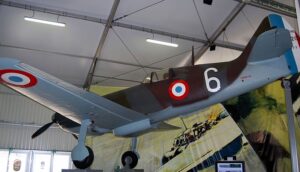Time Period: Interwar Period
Country of Origin: Germany
Type: Sport/Racer Aircraft
Manufacturer: Bayerische Flugzeugwerke (BFW), Messerschmitt AG
Messerschmitt Bf 108 Aircraft Overview
The Messerschmitt Bf 108 Taifun, meaning “typhoon” in German, was a versatile and elegant light utility aircraft developed in the 1930s by the German manufacturer Messerschmitt. Designed as a four-seat sports and touring aircraft, the Bf 108 quickly garnered acclaim for its exceptional performance, handling characteristics, and aesthetic appeal.
Introduced in 1934, the Bf 108 was powered by a single engine and featured a sleek, low-wing monoplane design, making it both agile and efficient in flight. Its advanced aerodynamics, coupled with its lightweight construction and powerful engine, allowed the Bf 108 to achieve impressive speed and range for its class.
One of the most notable features of the Bf 108 was its versatility. While primarily designed for civilian use, the aircraft demonstrated remarkable adaptability and was soon pressed into service for various military roles. During World War II, the Luftwaffe utilized the Bf 108 for reconnaissance, liaison, and transport duties, recognizing its reliability, range, and ease of handling.
In addition to its military applications, the Bf 108 also found success in civilian aviation, where it was favored by private pilots, flying clubs, and air racing enthusiasts. Its performance in air races and competitions further enhanced its reputation as a high-performance aircraft capable of meeting the demands of both recreational and professional aviators.
Overall, the Messerschmitt Bf 108 Taifun remains one of the most iconic and beloved aircraft of its era. Its timeless design, superb performance, and wide-ranging capabilities endeared it to pilots and enthusiasts alike, ensuring its lasting legacy in the annals of aviation history.
Messerschmitt Bf 108 Specifications
- Crew: 1 or 2
- Capacity: 2 or 3 passengers
- Length: 8.29 m (27 ft 2 in)
- Wingspan: 10.5 m (34 ft 5 in)
- Height: 2.3 m (7 ft 7 in)
- Wing area: 16.4 m2 (177 sq ft)
- Airfoil: root: NACA 2416; tip: NACA 2413
- Empty weight: 806 kg (1,777 lb)
- Gross weight: 1,350 kg (2,976 lb)
- Powerplant: 1 × Argus As 10C V-8 inverted air-cooled piston engine, 174 kW (233 hp)
- Propellers: 2-bladed variable-pitch propeller.
Messerschmitt Bf 108 Performance
- Maximum speed: 305 km/h (190 mph, 165 kn)
- Cruise speed: 260 km/h (160 mph, 140 kn)
- Landing speed: 85 km/h (53 mph; 46 kn)
- Range: 1,000 km (620 mi, 540 nmi) at 250 km/h (160 mph; 130 kn)
- Service ceiling: 6,200 m (20,300 ft) (with 3 pax + 50 kg (110 lb) baggage)
- Time to altitude: 1,000 m (3,300 ft) in 3 minutes 12 seconds. 2,000 m (6,600 ft) in 7 minutes 30 seconds. 3,000 m (9,800 ft) in 14 minutes. 4,000 m (13,000 ft) in 22 minutes. 5,000 m (16,000 ft) in 39 minutes
- Wing loading: 82.3 kg/m2 (16.9 lb/sq ft)
- Power/mass: 0.133 kW/kg (0.081 hp/lb)
Messerschmitt Bf 108 Image Gallery
More Messerschmitt Aircraft

Messerschmitt Me 262 Sturmvogel
The Messerschmitt Me 262 Sturmvogel is a fighter bomber aircraft and the world’s first jet-powered fighter aircraft.

Messerschmitt Me 209
The Messerschmitt Me 209 was a German single-engine racing aircraft designed to break speed records and used as a propaganda tool in WW2.

Messerschmitt P.1101
The Messerschmitt P.1101 was a single-seat jet fighter developed by Messerschmitt for the Third Reich during the Second World War.

Messerschmitt Me 163 Komet
The Messerschmitt Me 163 Komet was a German rocket-powered interceptor aircraft primarily used by the Luftwaffe in the 1940s.

Messerschmitt Bf 110
The Messerschmitt Bf 110 was a German twin-engine destroyer fighter-bomber developed in Nazi Germany in the 1930s and used in WW2.










